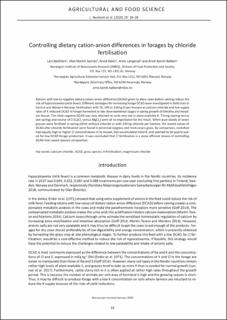| dc.contributor.author | Nesheim, Lars | |
| dc.contributor.author | Synnes, Olav Martin | |
| dc.contributor.author | Steen, Arvid | |
| dc.contributor.author | Langerud, Anne | |
| dc.contributor.author | Bakken, Anne Kjersti | |
| dc.date.accessioned | 2020-12-15T10:42:22Z | |
| dc.date.available | 2020-12-15T10:42:22Z | |
| dc.date.created | 2020-05-12T17:50:03Z | |
| dc.date.issued | 2020-03-30 | |
| dc.identifier.citation | Agricultural and Food Science. 2020, 29 (1), 18-28. | en_US |
| dc.identifier.issn | 1459-6067 | |
| dc.identifier.uri | https://hdl.handle.net/11250/2719480 | |
| dc.description.abstract | Rations with low to negative dietary cation-anion difference (DCAD) given to dairy cows before calving reduce the risk of hypocalcaemia (milk fever). Different strategies for increasing forage DCAD were investigated in field trials in Central and Western Norway. Fertilisation with 70, 140 or 210 kg Cl per hectare as calcium chloride and low supply rates of K reduced DCAD in forage harvested at late developmental stages in spring growth of timothy and mead-ow fescue. The ideal negative DCAD was only attained on soils very low in plant available K. Timing (spring versus late spring) and source of Cl (CaCl2 versus MgCl2) were of no importance for the result. When pure stands of seven grasses were fertilised in spring either without chloride or with 140 kg chloride per hectare, the lowest values of DCAD after chloride fertilisation were found in perennial ryegrass and reed canary grass. By comparison, cocksfoot had equally high or higher Cl concentrations in its tissues, but accumulated more K, and seemed to be poorly suit-ed for low DCAD forage production. It was concluded that Cl fertilisation is a more efficient means of controlling DCAD than sward species composition. | en_US |
| dc.language.iso | eng | en_US |
| dc.publisher | Scientific Agricultural Society of Finland | en_US |
| dc.rights | Navngivelse 4.0 Internasjonal | * |
| dc.rights.uri | http://creativecommons.org/licenses/by/4.0/deed.no | * |
| dc.title | Controlling dietary cation-anion differences in forages by chloride fertilisation | en_US |
| dc.type | Peer reviewed | en_US |
| dc.type | Journal article | en_US |
| dc.description.version | publishedVersion | en_US |
| dc.rights.holder | © The author(s) 2020 | en_US |
| dc.source.pagenumber | 18-28 | en_US |
| dc.source.volume | 29 | en_US |
| dc.source.journal | Agricultural and Food Science | en_US |
| dc.source.issue | 1 | en_US |
| dc.identifier.doi | 10.23986/afsci.88781 | |
| dc.identifier.cristin | 1810620 | |
| dc.relation.project | Regionale forskningsfond Midt-Norge: 217451 | en_US |
| cristin.ispublished | true | |
| cristin.fulltext | original | |
| cristin.qualitycode | 1 | |

